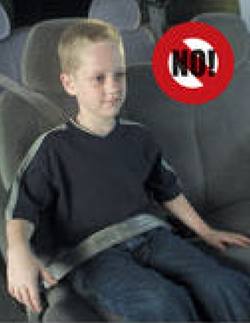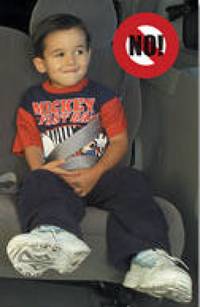Booster Seats
|
NO SHOULDER BELT BEHIND BACK
|
OR SHOULDER BELT UNDER ARM
|
 |
 |
Photos Courtesy of NHSTA
Using a booster seat with a seat belt instead of a seat belt alone reduces a child's risk of injury in a crash by 59%. A booster seat lifts small children up so the safety belt fits them properly. The lap belt needs to be fitted across the child's hips or pelvic area. If positioned too high, the belt can ride up over the stomach and the shoulder belt can slide up to the neck. This exposes the child to potential abdomen and/or neck injury. Naturally, the shoulder belt shouldn't be positioned behind the back (rendering it useless), or under the arm (potential injury to abdomen).
How to Mount Child Booster Seat
Mounting a child booster seat correctly is an important part of keeping your child safe while in the car. According to the National Highway Traffic Safety Administration (NHTSA), booster seats are essential for children who have outgrown their infant or toddler car seats, but are not yet big enough to use a regular seat belt. To ensure your child is properly secured in the car, it is important to properly mount their booster seat.
Step 1: Choose the Right Booster Seat
The first step in mounting your child’s booster seat is to make sure you have the right type of seat. The NHTSA recommends using a belt-positioning booster seat, which uses both the car’s lap and shoulder belt to secure the child. You should also make sure the booster seat has been crash tested and is approved for your child’s weight and height.
Step 2: Secure the Booster Seat
Once you have the right booster seat, it’s time to secure it in the car. The NHTSA recommends using the vehicle’s seat belt to secure the booster seat. The seat belt should be routed through the booster seat’s belt guides and tightened until it is snug. Make sure the seat belt is not twisted or bunched up.
Step 3: Adjust the Shoulder Belt
Once the booster seat is secured with the lap belt, it’s time to adjust the shoulder belt. The shoulder belt should be adjusted so it lies across the child’s collarbone and chest. It should not be resting on the child’s neck or stomach. If the seat belt has an adjustable shoulder belt guide, make sure it is positioned correctly.
Step 4: Check for Correct Fit
Once the booster seat is mounted and the shoulder belt is adjusted, it’s time to check for a correct fit. Make sure the booster seat is snug against the vehicle’s seat and that the lap belt is snug across the child’s hips. The child should be able to sit all the way back against the seat with their feet flat on the floor. If they cannot, the booster seat is not a good fit for the vehicle.
Step 5: Secure the Child
Once the booster seat is properly mounted, it’s time to secure the child. Make sure the child is sitting all the way back against the booster seat and the shoulder belt is snug across the child’s chest. The lap belt should be snug across the child’s hips. Make sure the child is not leaning forward or to the side, as this could lead to serious injury in the event of a crash.
Mounting a child booster seat correctly is an important part of keeping your child safe while in the car. By following these steps and making sure the booster seat is the right size for your child, you can help ensure your child is secure and safe during every ride.















